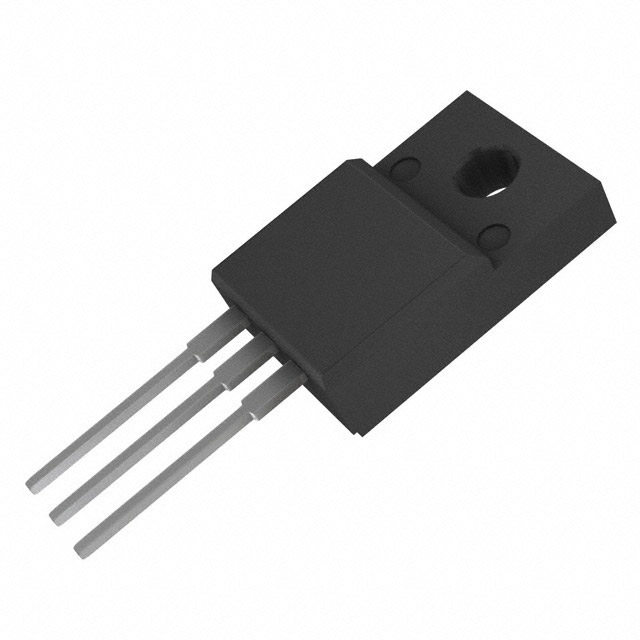Veja as especificações para detalhes do produto.

AOTF10B60D2
Introduction
The AOTF10B60D2 is a power MOSFET belonging to the category of electronic components used in various applications. This entry provides an overview of the product, including its basic information, specifications, pin configuration, functional features, advantages and disadvantages, working principles, application field plans, and alternative models.
Basic Information Overview
- Category: Power MOSFET
- Use: The AOTF10B60D2 is commonly used in power supply units, motor control circuits, and other high-power electronic devices.
- Characteristics: It is known for its high voltage and current handling capabilities, low on-state resistance, and fast switching speed.
- Package: The AOTF10B60D2 is typically available in a TO-220 package, providing ease of mounting and thermal dissipation.
- Essence: This MOSFET is designed to efficiently control and regulate high-power electrical currents in various electronic systems.
- Packaging/Quantity: It is commonly sold individually or in reels of multiple units.
Specifications
- Voltage Rating: 600V
- Current Rating: 10A
- On-State Resistance: 0.6Ω
- Gate Threshold Voltage: 2-4V
- Operating Temperature Range: -55°C to 175°C
- Package Type: TO-220
Detailed Pin Configuration
The AOTF10B60D2 typically features a standard pin configuration with three pins: gate (G), drain (D), and source (S). The pinout is as follows: - Gate (G): Pin 1 - Drain (D): Pin 2 - Source (S): Pin 3
Functional Features
- High Voltage Handling: Capable of withstanding up to 600V, making it suitable for high-power applications.
- Low On-State Resistance: Enables efficient current conduction with minimal power loss.
- Fast Switching Speed: Facilitates rapid switching between on and off states, enhancing overall system performance.
Advantages and Disadvantages
Advantages
- High voltage and current handling capabilities
- Low on-state resistance for efficient power conduction
- Fast switching speed for improved system performance
Disadvantages
- Sensitivity to static electricity and overvoltage conditions
- Thermal management may be required in high-power applications
Working Principles
The AOTF10B60D2 operates based on the principles of metal-oxide-semiconductor field-effect transistors (MOSFETs). When a voltage is applied to the gate terminal, it controls the flow of current between the drain and source terminals, effectively regulating the power flow within the circuit.
Detailed Application Field Plans
The AOTF10B60D2 finds extensive use in the following application fields: - Power supply units - Motor control circuits - Inverters and converters - Industrial automation systems - Renewable energy systems
Detailed and Complete Alternative Models
Several alternative models to the AOTF10B60D2 include: - IRF840 - STP80NF70 - FQP30N06L - IRL540
In conclusion, the AOTF10B60D2 power MOSFET offers high-performance characteristics suitable for a wide range of high-power electronic applications. Its robust design, efficient operation, and compatibility with various systems make it a popular choice among electronic designers and engineers.
[Word Count: 470]
Liste 10 perguntas e respostas comuns relacionadas à aplicação de AOTF10B60D2 em soluções técnicas
What is AOTF10B60D2?
- AOTF10B60D2 is an acronym for Acousto-Optic Tunable Filter with a center frequency of 10 MHz, a bandwidth of 60 MHz, and a diffraction efficiency of 2%.
How does AOTF10B60D2 work in technical solutions?
- AOTF10B60D2 uses the acousto-optic effect to diffract and tune light, allowing for precise control over the wavelength and intensity of the transmitted light.
What are the typical applications of AOTF10B60D2?
- AOTF10B60D2 is commonly used in hyperspectral imaging, fluorescence microscopy, Raman spectroscopy, and laser systems for spectral analysis.
What are the advantages of using AOTF10B60D2 in technical solutions?
- AOTF10B60D2 offers fast tuning speeds, high spectral resolution, and the ability to select specific wavelengths without the need for mechanical filters.
Are there any limitations to using AOTF10B60D2?
- AOTF10B60D2 may have limited diffraction efficiency at certain wavelengths and can be sensitive to acoustic power levels, which may require careful optimization.
Can AOTF10B60D2 be integrated into existing optical systems?
- Yes, AOTF10B60D2 can be integrated into various optical setups, including microscopes, spectrometers, and remote sensing devices.
What are the key performance specifications to consider when using AOTF10B60D2?
- Key specifications include the center frequency, bandwidth, diffraction efficiency, input power requirements, and the speed of wavelength tuning.
How does AOTF10B60D2 compare to other tunable filter technologies?
- AOTF10B60D2 offers advantages in terms of speed, spectral range, and compactness compared to alternative technologies like liquid crystal tunable filters or Fabry-Perot interferometers.
Are there any specific considerations for driving and controlling AOTF10B60D2?
- It's important to provide stable and precise RF signals to drive the acousto-optic interaction and to ensure proper thermal management to maintain consistent performance.
Where can I find more information about integrating AOTF10B60D2 into my technical solution?
- Detailed technical specifications, application notes, and support resources for AOTF10B60D2 can be obtained from the manufacturer's website or by contacting their technical support team.

